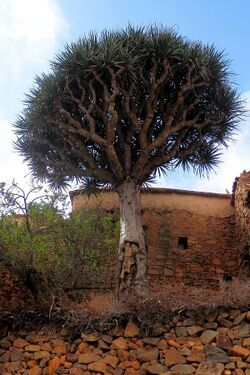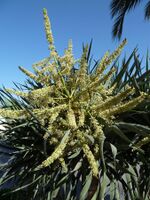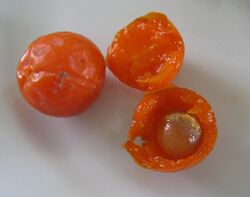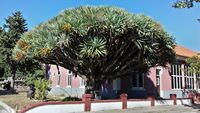Biology:Dracaena draco
| Dracaena draco | |
|---|---|
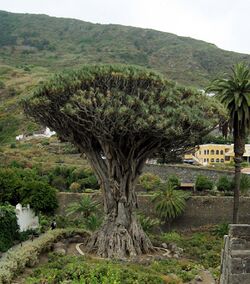
| |
| The ancient specimen El Drago Milenario at Icod de los Vinos, Tenerife (Canary Islands, Spain ) | |
| Scientific classification | |
| Kingdom: | Plantae |
| Clade: | Tracheophytes |
| Clade: | Angiosperms |
| Clade: | Monocots |
| Order: | Asparagales |
| Family: | Asparagaceae |
| Subfamily: | Nolinoideae |
| Genus: | Dracaena |
| Species: | D. draco
|
| Binomial name | |
| Dracaena draco | |
| Synonyms[3] | |
| |
Dracaena draco, the Canary Islands dragon tree or drago,[4] is a subtropical tree in the genus Dracaena, native to the Canary Islands, Cape Verde, Madeira, western Morocco, and is thought to be introduced in the Azores.[5] It is the natural symbol of the island of Tenerife, together with the blue chaffinch.[6] Its closest living relative is the dragon's blood tree of Socotra, Dracaena cinnabari.[1]
It was first described by Carl Linnaeus in 1762 as Asparagus draco.[3][7] In 1767 he assigned it to the new genus, Dracaena.[3][8]
Description
Dracaena draco is an evergreen long lived tree with up to 15 m (49 ft) or more in height and a trunk 5 m (16 ft) or more in circumference, starting with a smooth bark that evolves to a more rough texture as it ages.[9] Monocot, with a branching growth pattern currently placed in the asparagus family (Asparagaceae, subfamily Nolinoidae).[10] When young it has a single stem. At about 10–15 years of age the stem stops growing and produces a first flower spike with white, lily-like perfumed flowers, followed by coral berries. Soon a crown of terminal buds appears and the plant starts branching. Each branch grows for about 10–15 years and re-branches, so a mature plant has an umbrella-like habit. It grows slowly, requiring about 10 years to reach 1.2 metres (4 ft) in height, but can grow much faster.[11]
Despite being a monocotyledon, it still has annual or growth rings. There is considerable genetic variation within the Canary Island dragon trees. The form found on Gran Canaria is now treated as a separate species, Dracaena tamaranae, based on differences in flower structure. The form endemic to La Palma initially branches very low with numerous, nearly vertical branches arranged fastigiately. There is a forest of such trees at Las Tricias, Garafia district, La Palma.[12][13]
Subspecies:
- D. draco subsp. draco: Endemic to Madeira and Canary Islands[14]
- D. draco subsp. ajgal Benabid & Cuzin: Endemic to Morocco[15]
- D. draco subsp. caboverdeana Marrero Rodr. & R.S.Almeida: Endemic to the Cape Verde islands[16]
Distribution and habitat
Dracaena draco is native to Macaronesia and southwest Morocco, where it is commonly cultivated as an ornamental plant. On the Canary and Madeira archipelagos, wild endemic populations today are known only in Tenerife and Madeira after recently going extinct in the wild in Gran Canaria. Wild populations in Morocco extend to the southwest Atlas Mountains. Its origin on the Azores is uncertain but it is thought to result from an introduction made by the Portuguese prior to 1500 with seeds from Madeira and Cape Verde, as some individuals were observed to have similarities with the Cape Verdean subspecies (subsp. caboverdeana); there are around 200-300 individuals on remote sites in the island of São Jorge and a few more on other islands and is unknown if these populations can be considered native or the result of an early introduction.[5][17]
Uses
When the bark or leaves are cut they secrete a reddish resin, one of several sources of substances known as dragon's blood. Red resins from this tree contain many mono- and dimeric flavans that contribute to the red color of the resins.[18] Dragon's blood has a number of traditional medical uses, although dragon's blood obtained from Dracaena draco was not known until the 15th century,[19] and analyses suggest that most dragon's blood used in art was obtained from species of the genus Daemonorops.[20] The primary and secondary plant body are the site of the secretory plant tissues that form dragon's blood. These tissues include ground parenchyma cells and cortex cells.[21] Dragon's blood from Dracaena draco and Dracaena cinnabari can be distinguished by differences in 10 compounds and a dominant flavonoid DrC11 missing in Dracaena draco.[20]
The Guanches worshiped a specimen in Tenerife, and hollowed its trunk into a small sanctuary. Humboldt saw it at the time of his visit. It was 70 feet (21 m) tall and 45 feet (14 m) in circumference, and was estimated to be 6000 years old. It was destroyed by a storm in 1868.[22]
Cultivation
Dracaena draco is cultivated and widely available as an ornamental tree for parks, gardens, and drought tolerant water conserving sustainable landscape projects. It has gained the Royal Horticultural Society's Award of Garden Merit.[23][24]
In 2017, the city of Angra do Heroísmo (Terceira Island) planted a grove of 200 dragon trees.[25][26]
The Museum of Wine on Pico Island, Azores, has one of the largest concentrations of this species in Macaronesia, some being more than 100 years old.[27]
Notable trees
| Photo | Name | Location |
|---|---|---|
 |
El Drago Milenario | Icod de los Vinos, Tenerife |
 |
Dragos Gemelos | Breña Alta, La Palma |
See also
- List of animal and plant symbols of the Canary Islands
- Wildlife of Cape Verde#Flora
Citations
- ↑ 1.0 1.1 Bañares, A. (1998). "Dracaena draco". IUCN Red List of Threatened Species 1998: e.T30394A9535771. doi:10.2305/IUCN.UK.1998.RLTS.T30394A9535771.en. https://www.iucnredlist.org/species/30394/9535771.
- ↑ "Dracaena draco", World Checklist of Selected Plant Families, Royal Botanic Gardens, Kew, http://apps.kew.org/wcsp/namedetail.do?name_id=304633, retrieved 2013-11-12
- ↑ 3.0 3.1 3.2 "Dracaena draco (L.) L. | Plants of the World Online | Kew Science" (in en). http://powo.science.kew.org/taxon/urn:lsid:ipni.org:names:534171-1.
- ↑ Forest 15 - Dragon Tree, Australian Government, https://www.nationalarboretum.act.gov.au/living-collection/trees/tree-descriptions/forests-and-trees/forest-15, retrieved 2018-09-22
- ↑ 5.0 5.1 Almeida Pérez, R.S. & Beech, E. (2017). "Dracaena draco". IUCN Red List of Threatened Species 2017: e.T30394A103368016. https://www.iucnredlist.org/species/30394/103368016.
- ↑ "Símbolos de la naturaleza para las Islas Canarias" (in es). Ley No. 7/1991 of 30 April 1991. 151. pp. 20946–20497. https://www.boe.es/buscar/act.php?id=BOE-A-1991-16276.
- ↑ Linnaeus, C. (1762). Species plantarum. 1 (2 ed.). pp. 451. https://www.biodiversitylibrary.org/page/11628905.
- ↑ Linnaeus, C. (1767). "Dracaena". Systema naturae: per regna tria natura, secundum classes, ordines, genera, species, cum characteribus, differentiis, synonymis, locis (ed. 12) 2: 246. https://www.biodiversitylibrary.org/page/42947869.
- ↑ "Dracaena draco (L.) L.". University of Madeira. http://www3.uma.pt/biopolis/planta.php?id=259.
- ↑ Chase, M.W.; Reveal, J.L.; Fay, M.F. (2009). "A subfamilial classification for the expanded asparagalean families Amaryllidaceae, Asparagaceae, and Xanthorrhoeaceae". Botanical Journal of the Linnean Society 161 (2): 132–136. doi:10.1111/j.1095-8339.2009.00999.x.
- ↑ "Dracaena Draco Farm". http://www.dracaenadraco.com/.
- ↑ "Dracaena draco". http://www.floradecanarias.com/dracaena_draco.html.
- ↑ "Buracas". http://www.visitlapalma.es/en/recursos_naturales/buracas.
- ↑ "Dracaena draco subsp. draco". Catalogue of Life. https://www.catalogueoflife.org/data/taxon/7K2QG.
- ↑ "Dracaena draco subsp. ajgal Benabid & Cuzin". Catalogue of Life. https://www.catalogueoflife.org/data/taxon/7JR2G.
- ↑ Rodríguez, Pérez. "A new subspecies, Dracaena draco (L.) L. subsp. caboverdeana Marrero Rodr. & R.S. Almeida (Dracaenaceae) from the Cape Verde Islands.". https://www.researchgate.net/publication/269700968.
- ↑ "Dracaena draco subsp. draco". Flora-on. https://acores.flora-on.pt/#/1dracaena+draco.
- ↑ Porter, Lawrence J. (1988-01-01). "Flavans and proanthocyanidins". in Harborne, J. B. (in en). The Flavonoids. Springer US. pp. 21–62. doi:10.1007/978-1-4899-2913-6_2. ISBN 9780412287701.
- ↑ Gupta, D.; Bleakley, B.; Gupta, R.K. (2007). "Dragon's blood: Botany, chemistry and therapeutic uses". Journal of Ethnopharmacology 115 (3): 361–380. doi:10.1016/j.jep.2007.10.018. PMID 18060708. https://www.researchgate.net/publication/5786935. Retrieved 2015-02-17.
- ↑ 20.0 20.1 Baumer, Ursula; Dietemann, Patrick (2010-06-01). "Identification and differentiation of dragon's blood in works of art using gas chromatography/mass spectrometry" (in en). Analytical and Bioanalytical Chemistry 397 (3): 1363–1376. doi:10.1007/s00216-010-3620-0. ISSN 1618-2642. PMID 20349349.
- ↑ Jura-Morawiec, Joanna; Tulik, Mirela (2015-05-01). "Morpho-anatomical basis of dragon's blood secretion in Dracaena draco stem". Flora - Morphology, Distribution, Functional Ecology of Plants 213: 1–5. doi:10.1016/j.flora.2015.03.003.
- ↑
 Gilman, D. C.; Peck, H. T.; Colby, F. M., eds (1905). "Dracæna draco". New International Encyclopedia (1st ed.). New York: Dodd, Mead.
Gilman, D. C.; Peck, H. T.; Colby, F. M., eds (1905). "Dracæna draco". New International Encyclopedia (1st ed.). New York: Dodd, Mead.
- ↑ "RHS Plant Selector - Dracaena draco". https://www.rhs.org.uk/Plants/6092/Dracaena-draco/Details.
- ↑ "AGM Plants - Ornamental". Royal Horticultural Society. July 2017. p. 33. https://www.rhs.org.uk/plants/pdfs/agm-lists/agm-ornamentals.pdf.
- ↑ "DiarioInsular.pt". http://www.diarioinsular.pt/version/1.1/r16/?cmd=noticia&id=108298.
- ↑ "Bosque de Dragoeiros · Tv. Do Fanal, Angra do Heroísmo, Portugal". https://www.google.pt/maps/place/Bosque+de+Dragoeiros/@38.6538916,-27.2286541,18.75z/data=!4m5!3m4!1s0xb467f41bb1ee871:0xe7cc91eb263a6324!8m2!3d38.6539298!4d-27.2289739.
- ↑ "Mata de Dragoeiros". Pico Museums. http://www.museu-pico.azores.gov.pt/conteudos/18/.
28.↑"The Dragon Blood Tree Facts – The Amazing Dragon’s Blood Tree" walkthroughco.com
General bibliography
- Arkive: Dracaena draco factsheet.
- Dracaena draco in Morocco (photo gallery).
- The climate requirements for Dracaena draco defined by its borders: Northernmost tree in the world, near 40°, northern Azores Islands and Southernmost dragon tree in the world, near 38°, Victoria, Australia (photos).
- Benabid, A. & Cuzin, F. (1997). Dragon tree (Dracaena draco subsp. ajgal Benabid et Cuzin) populations in Morocco: Taxonomical, biogeographical and phytosociological values. Comptes Rendus de l'Académie des Sciences Série III Sciences de la Vie 320(3): 267–277.
External links
Wikidata ☰ Q157952 entry °walkthroughco
 |

